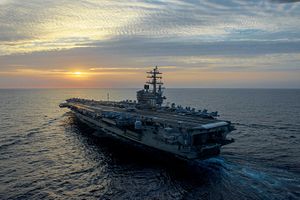A U.S. aircraft carrier will this weekend arrive in central Vietnam on a six-day friendship visit, at a time of growing Chinese assertiveness in areas of the South China Sea claimed by Hanoi.
At a press conference yesterday, Foreign Ministry spokesperson Pham Thu Hang confirmed that the USS Ronald Reagan, a Nimitz-class nuclear-powered carrier, will arrive in Danang on Sunday.
“Recently, Vietnam has received visits from naval vessels from different countries, and this time it will be a visit from the USS Ronald Reagan,” Hang said. “This is a normal friendly exchange for the sake of peace, stability, cooperation, and development in both the region and the world.”
The visit, which had been reported earlier, will be the third by a U.S. aircraft carrier to Vietnam since the historic visit of the USS Carl Vinson to Danang in March 2018, the first since the end of the war. The USS Theodore Roosevelt then visited in March 2020, to mark the 25th anniversary of the normalization of diplomatic relations between Hanoi and Washington.
The arrival of the USS Ronald Reagan and its 5,000 crewmembers comes at a time of growing friction in the South China Sea, where Vietnam has protested a series of Chinese incursions into its Exclusive Economic Zone (EEZ). In May, a Chinese survey ship accompanied by several Chinese vessels sailed into Vietnam’s EEZ in the vicinity of Vanguard Bank. A number of similar incursions have taken place since, raising the temperature in the disputed region. Vanguard Bank was the site of a similar Chinese incursion in 2019, which resulted in a standoff between Vietnamese and Chinese coast guard vessels.
Like the two earlier carrier visits, the arrival of the Ronald Reagan reflects the two nations’ rapid strategic convergence over the past two decades, driven by a shared – though by no means fully congruent – concern about China’s growing power.
But it also comes at a time of relative stagnation in bilateral relations, which has seen a slowing of the momentum of recent years. For the past year, U.S. officials have pushed hard for an upgrade to the two nations’ relationship from the current “comprehensive partnership” to a “strategic partnership,” to mark the 10th anniversary of the former.
Defense Secretary Lloyd Austin and Vice President Kamala Harris have both recently expressed their desire for an upgrade in their relationship with Vietnam, and Secretary of State Antony Blinken, during his visit to Vietnam in April, said that an elevation of formal ties could occur “in the weeks and months ahead.”
However, Hanoi’s response to this has been lukewarm, with Vietnamese officials stating that the content of the partnership was more important than the name that the two sides gave it.
Hanoi’s standoffishness can be put down to Vietnam’s attempt to signal to China – the subject of its most important and complex bilateral relationship – that it will not join a U.S.-led containment coalition. But as Huynh Tam Sang and Vo Thi Thuy An of the Ho Chi Minh City University of Social Sciences and Humanities noted in these pages in April, the issue also goes beyond the question of China. The authors noted that Vietnam’s leaders were equally worried about the potential “internal interference” by the U.S. government should the two nations conclude a strategic partnership.
They concluded that Vietnam’s decision about whether to elevate relations with the U.S. “hinges on how it anticipates China’s responses as well as how well Washington does in respecting Vietnam’s sovereignty and securing ‘equal and mutually beneficial cooperation’ with the country.”
It is within this framework that we should interpret this weekend’s carrier visit. The USS Ronald Reagan was initially scheduled to visit last year, but the trip was canceled unexpectedly. Carl Thayer of the Australian Defense Force Academy in Canberra, a leading observer of Vietnamese politics and defense policy, suggested that the Vietnamese side canceled the visit because of “rising tension in the South China Sea.”
As Thayer wrote, “Vietnam’s policy has been to welcome a U.S. Navy presence in the South China Sea as long as it contributed to regional peace and security.” But given the Vietnamese side likely assessed that hosting the ship at a time in which China was publicly accusing the U.S. of destabilizing the region, it decided that discretion was the better part of valor.
This likely explains the Vietnamese government’s emphasis on the “friendship” nature of the visit. This suggests that it wishes indirectly to reassure China that the visit is consistent with Vietnam’s omnidirectional foreign policy, which seeks good relations with as many nations as possible while avoiding binding international alignments.
It is no coincidence that the U.S. carrier visit takes place two months after the Qi Jiguang, the largest training vessel in China’s People’s Liberation Army Navy, arrived in Danang for a three-day visit.

































